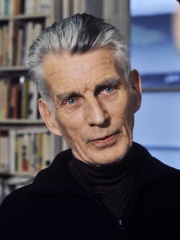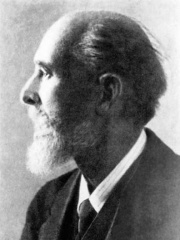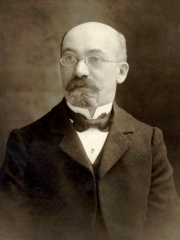WRITER
Henryk Sienkiewicz
1846 - 1916

 Henryk Sienkiewicz
Henryk Sienkiewicz
Henryk Adam Aleksander Pius Sienkiewicz (US: shen-KYAY-vitch, -KYEV-itch, Polish: [ˈxɛnrɨk ˈadam alɛkˈsandɛr ˈpjus ɕɛnˈkʲɛvit͡ʂ]; 5 May 1846 – 15 November 1916), also known by the pseudonym Litwos (Polish pronunciation: [ˈlitfɔs]), was a Polish epic writer. He is remembered for his historical novels, such as the Trilogy series and especially for his internationally known best-seller Quo Vadis (1895–1896). Born into an impoverished Polish noble family in the Kingdom of Poland, at the time part of the Russian Empire, he began publishing journalistic and literary pieces in the late 1860s. In the late 1870s he traveled to the United States, sending back travel essays that won him popularity with Polish readers. Read more on Wikipedia
His biography is available in 99 different languages on Wikipedia (up from 98 in 2024). Henryk Sienkiewicz is the 160th most popular writer (up from 225th in 2024), the 16th most popular biography from Poland (up from 30th in 2019) and the 2nd most popular Polish Writer.
Henryk Sienkiewicz is most famous for writing the novel Quo Vadis.
Memorability Metrics
Page views of Henryk Sienkiewicz by language
Among WRITERS
Among writers, Henryk Sienkiewicz ranks 160 out of 7,302. Before him are Yasunari Kawabata, H. P. Lovecraft, Mary Shelley, Samuel Beckett, Eugène Ionesco, and Ivan Turgenev. After him are Tomas Tranströmer, Guillaume Apollinaire, Jean Racine, Elias Canetti, Elizabeth Barrett Browning, and Novalis.
Most Popular Writers in Wikipedia
Go to all RankingsYasunari Kawabata
1899 - 1972
HPI: 79.61
Rank: 154
H. P. Lovecraft
1890 - 1937
HPI: 79.50
Rank: 155
Mary Shelley
1797 - 1851
HPI: 79.46
Rank: 156
Samuel Beckett
1906 - 1989
HPI: 79.46
Rank: 157
Eugène Ionesco
1909 - 1994
HPI: 79.45
Rank: 158
Ivan Turgenev
1818 - 1883
HPI: 79.43
Rank: 159
Henryk Sienkiewicz
1846 - 1916
HPI: 79.31
Rank: 160
Tomas Tranströmer
1931 - 2015
HPI: 79.26
Rank: 161
Guillaume Apollinaire
1880 - 1918
HPI: 79.26
Rank: 162
Jean Racine
1639 - 1699
HPI: 79.26
Rank: 163
Elias Canetti
1905 - 1994
HPI: 79.19
Rank: 164
Elizabeth Barrett Browning
1806 - 1861
HPI: 79.12
Rank: 165
Novalis
1772 - 1801
HPI: 79.08
Rank: 166
Contemporaries
Among people born in 1846, Henryk Sienkiewicz ranks 2. Before him is Rudolf Christoph Eucken. After him are Princess Helena of the United Kingdom, Peter Carl Fabergé, Wilhelm Maybach, Buffalo Bill, Comte de Lautréamont, George Westinghouse, Edmondo De Amicis, Wladimir Köppen, Isabel, Princess Imperial of Brazil, and Prince Leopold of Bavaria. Among people deceased in 1916, Henryk Sienkiewicz ranks 4. Before him are Franz Joseph I of Austria, Grigori Rasputin, and Jack London. After him are William Ramsay, Herbert Kitchener, 1st Earl Kitchener, Ernst Mach, Élie Metchnikoff, Yuan Shikai, Charles Taze Russell, Klas Pontus Arnoldson, and Odilon Redon.
Others Born in 1846
Go to all RankingsRudolf Christoph Eucken
PHILOSOPHER
1846 - 1926
HPI: 79.85
Rank: 1
Henryk Sienkiewicz
WRITER
1846 - 1916
HPI: 79.31
Rank: 2
Princess Helena of the United Kingdom
COMPANION
1846 - 1923
HPI: 77.31
Rank: 3
Peter Carl Fabergé
DESIGNER
1846 - 1920
HPI: 77.25
Rank: 4
Wilhelm Maybach
INVENTOR
1846 - 1929
HPI: 73.59
Rank: 5
Buffalo Bill
CELEBRITY
1846 - 1917
HPI: 73.42
Rank: 6
Comte de Lautréamont
WRITER
1846 - 1870
HPI: 73.06
Rank: 7
George Westinghouse
INVENTOR
1846 - 1914
HPI: 72.92
Rank: 8
Edmondo De Amicis
WRITER
1846 - 1908
HPI: 72.68
Rank: 9
Wladimir Köppen
GEOGRAPHER
1846 - 1940
HPI: 72.08
Rank: 10
Isabel, Princess Imperial of Brazil
NOBLEMAN
1846 - 1921
HPI: 71.13
Rank: 11
Prince Leopold of Bavaria
NOBLEMAN
1846 - 1930
HPI: 70.40
Rank: 12
Others Deceased in 1916
Go to all RankingsFranz Joseph I of Austria
POLITICIAN
1830 - 1916
HPI: 90.65
Rank: 1
Grigori Rasputin
OCCULTIST
1869 - 1916
HPI: 85.15
Rank: 2
Jack London
WRITER
1876 - 1916
HPI: 81.73
Rank: 3
Henryk Sienkiewicz
WRITER
1846 - 1916
HPI: 79.31
Rank: 4
William Ramsay
CHEMIST
1852 - 1916
HPI: 79.11
Rank: 5
Herbert Kitchener, 1st Earl Kitchener
ENGINEER
1850 - 1916
HPI: 79.10
Rank: 6
Ernst Mach
PHYSICIST
1838 - 1916
HPI: 77.25
Rank: 7
Élie Metchnikoff
BIOLOGIST
1845 - 1916
HPI: 77.11
Rank: 8
Yuan Shikai
POLITICIAN
1859 - 1916
HPI: 76.77
Rank: 9
Charles Taze Russell
RELIGIOUS FIGURE
1852 - 1916
HPI: 76.57
Rank: 10
Klas Pontus Arnoldson
POLITICIAN
1844 - 1916
HPI: 76.20
Rank: 11
Odilon Redon
PAINTER
1840 - 1916
HPI: 75.03
Rank: 12
In Poland
Among people born in Poland, Henryk Sienkiewicz ranks 16 out of 1,694. Before him are Maria Goeppert Mayer (1906), L. L. Zamenhof (1859), Paul von Hindenburg (1847), David Ben-Gurion (1886), Günter Grass (1927), and Johann Gottfried Herder (1744). After him are Daniel Gabriel Fahrenheit (1686), Wisława Szymborska (1923), Fritz Haber (1868), Adam Mickiewicz (1798), Eric of Pomerania (1381), and Otto Stern (1888).
Others born in Poland
Go to all RankingsMaria Goeppert Mayer
PHYSICIST
1906 - 1972
HPI: 82.73
Rank: 10
L. L. Zamenhof
PHYSICIAN
1859 - 1917
HPI: 82.06
Rank: 11
Paul von Hindenburg
POLITICIAN
1847 - 1934
HPI: 81.91
Rank: 12
David Ben-Gurion
POLITICIAN
1886 - 1973
HPI: 81.57
Rank: 13
Günter Grass
WRITER
1927 - 2015
HPI: 80.42
Rank: 14
Johann Gottfried Herder
PHILOSOPHER
1744 - 1803
HPI: 79.32
Rank: 15
Henryk Sienkiewicz
WRITER
1846 - 1916
HPI: 79.31
Rank: 16
Daniel Gabriel Fahrenheit
PHYSICIST
1686 - 1736
HPI: 79.17
Rank: 17
Wisława Szymborska
WRITER
1923 - 2012
HPI: 78.89
Rank: 18
Fritz Haber
CHEMIST
1868 - 1934
HPI: 78.61
Rank: 19
Adam Mickiewicz
WRITER
1798 - 1855
HPI: 78.60
Rank: 20
Eric of Pomerania
PIRATE
1381 - 1459
HPI: 78.58
Rank: 21
Otto Stern
PHYSICIST
1888 - 1969
HPI: 78.32
Rank: 22
Among WRITERS In Poland
Among writers born in Poland, Henryk Sienkiewicz ranks 2. Before him are Günter Grass (1927). After him are Wisława Szymborska (1923), Adam Mickiewicz (1798), Janusz Korczak (1878), Isaac Bashevis Singer (1902), Gerhart Hauptmann (1862), Andrzej Sapkowski (1948), Alfred Döblin (1878), Władysław Reymont (1867), Osip Mandelstam (1891), and Olga Tokarczuk (1962).
Günter Grass
1927 - 2015
HPI: 80.42
Rank: 1
Henryk Sienkiewicz
1846 - 1916
HPI: 79.31
Rank: 2
Wisława Szymborska
1923 - 2012
HPI: 78.89
Rank: 3
Adam Mickiewicz
1798 - 1855
HPI: 78.60
Rank: 4
Janusz Korczak
1878 - 1942
HPI: 77.74
Rank: 5
Isaac Bashevis Singer
1902 - 1991
HPI: 77.49
Rank: 6
Gerhart Hauptmann
1862 - 1946
HPI: 76.95
Rank: 7
Andrzej Sapkowski
1948 - Present
HPI: 73.44
Rank: 8
Alfred Döblin
1878 - 1957
HPI: 72.90
Rank: 9
Władysław Reymont
1867 - 1925
HPI: 72.79
Rank: 10
Osip Mandelstam
1891 - 1938
HPI: 72.25
Rank: 11
Olga Tokarczuk
1962 - Present
HPI: 70.79
Rank: 12






















































